
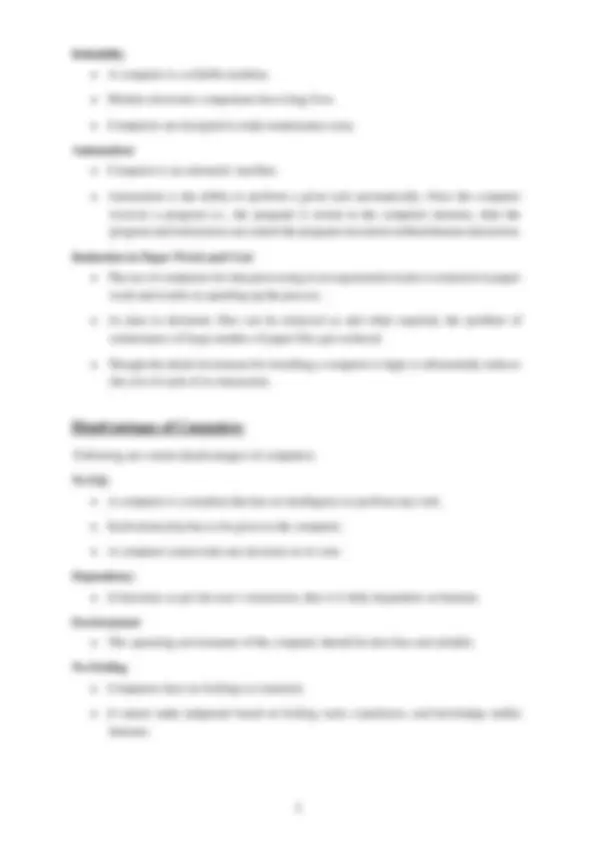
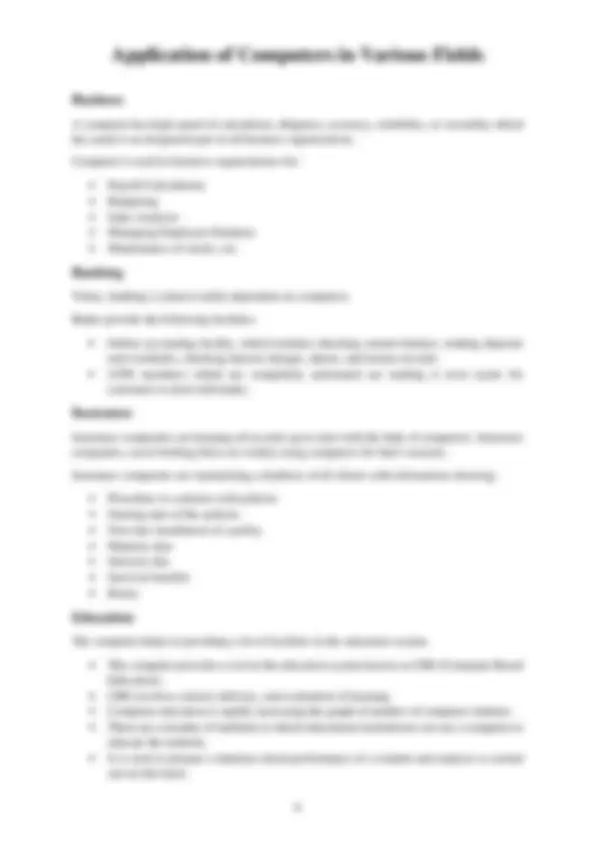
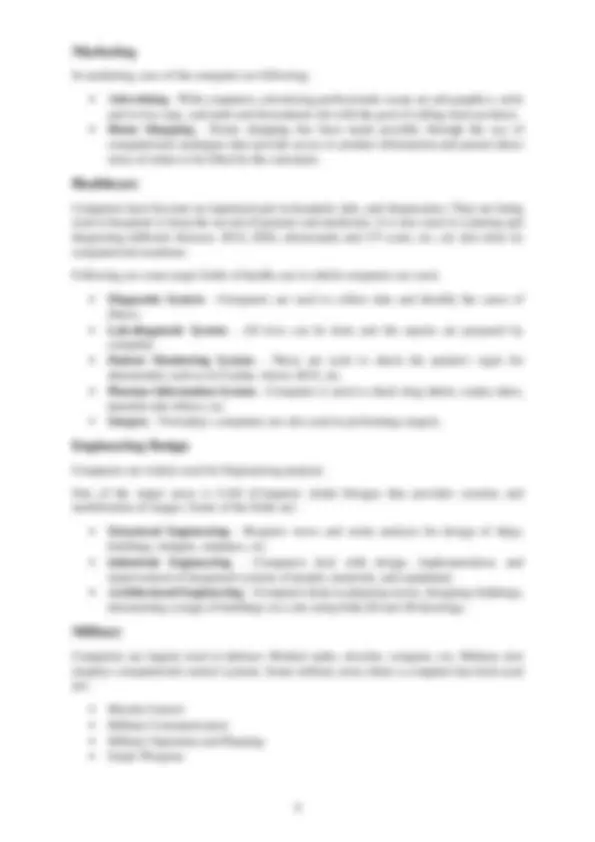
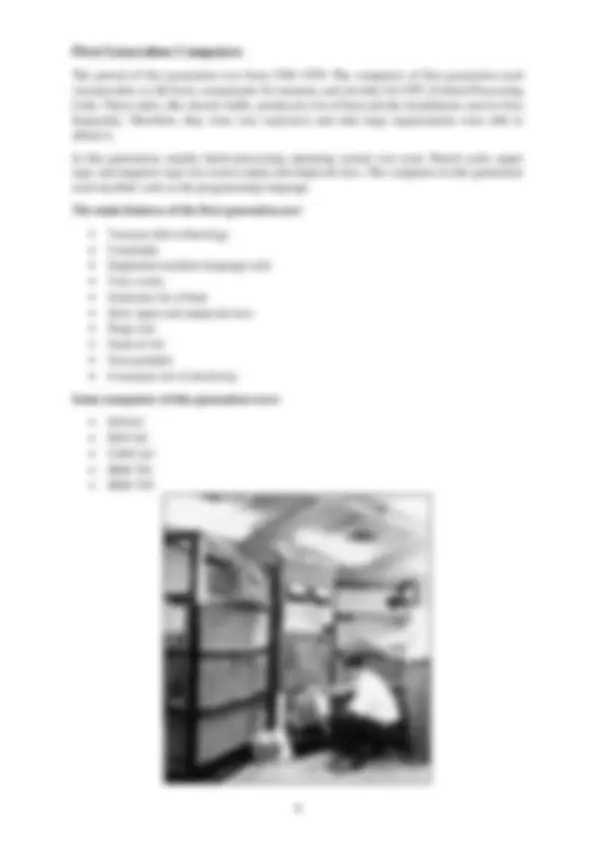
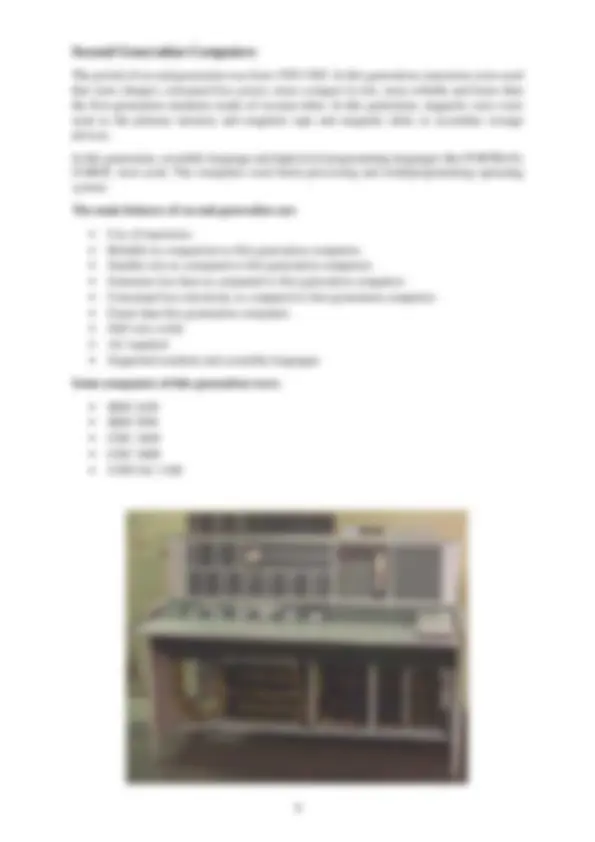
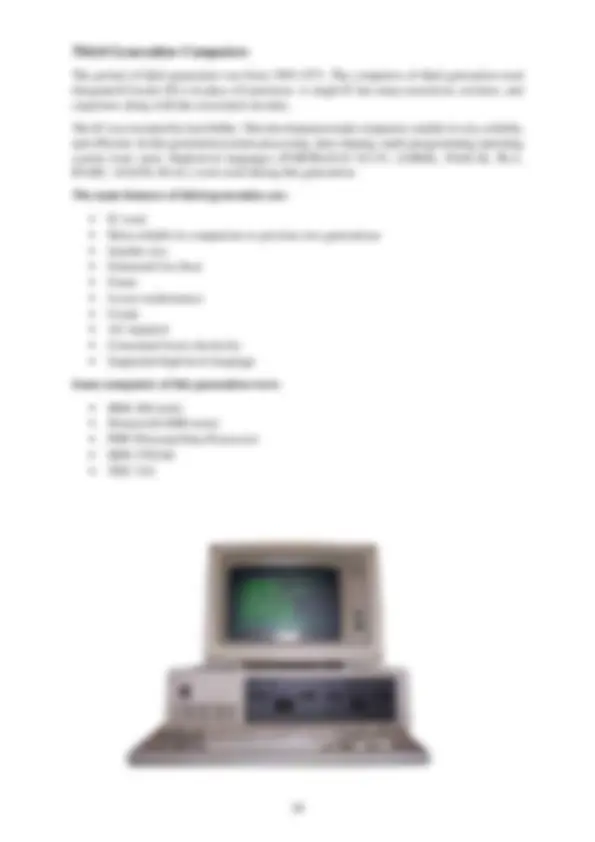


Study with the several resources on Docsity

Earn points by helping other students or get them with a premium plan


Prepare for your exams
Study with the several resources on Docsity

Earn points to download
Earn points by helping other students or get them with a premium plan
Community
Ask the community for help and clear up your study doubts
Discover the best universities in your country according to Docsity users
Free resources
Download our free guides on studying techniques, anxiety management strategies, and thesis advice from Docsity tutors
This tutorial explains the foundational concepts of computer hardware, software, operating systems, peripherals, etc. along with how to get the most value and ...
Typology: Study notes
1 / 12

This page cannot be seen from the preview
Don't miss anything!







Computer is an advanced electronic device that takes raw data as an input from the user and processes it under the control of a set of instructions (called program), produces a result (output), and saves it for future use. This tutorial explains the foundational concepts of computer hardware, software, operating systems, peripherals, etc. along with how to get the most value and impact from computer technology.
There are three basic functionalities of a Computer System and they are
But if we look at it in a very broad sense, any digital computer carries out the following five functions:
Step 1 - Takes data as input.
Step 2 - Stores the data/instructions in its memory and uses them as required.
Step 3 - Processes the data and converts it into useful information.
Step 4 - Generates the output.
Step 5 - Controls all the above four steps.
Following are certain advantages of computers.
High Speed
Accuracy
Storage Capability
Diligence
Versatility
A computer has high speed of calculation, diligence, accuracy, reliability, or versatility which has made it an integrated part in all business organizations.
Computer is used in business organizations for:
Today, banking is almost totally dependent on computers.
Banks provide the following facilities:
Insurance companies are keeping all records up-to-date with the help of computers. Insurance companies, stock broking firms are widely using computers for their concerns.
Insurance companies are maintaining a database of all clients with information showing:
The computer helps in providing a lot of facilities in the education system.
In marketing, uses of the computer are following:
Computers have become an important part in hospitals, labs, and dispensaries. They are being used in hospitals to keep the record of patients and medicines. It is also used in scanning and diagnosing different diseases. ECG, EEG, ultrasounds and CT scans, etc. are also done by computerized machines.
Following are some major fields of health care in which computers are used.
Computers are widely used for Engineering purpose.
One of the major areas is CAD (Computer Aided Design) that provides creation and modification of images. Some of the fields are:
Computers are largely used in defence. Modern tanks, missiles, weapons, etc. Military also employs computerized control systems. Some military areas where a computer has been used are:
Generation in computer terminology is a change in technology a computer is/was being used. Initially, the generation term was used to distinguish between varying hardware technologies. Nowadays, generation includes both hardware and software, which together make up an entire computer system.
There are five computer generations known till date. Each generation has been discussed in detail along with their time period and characteristics. In the following table, approximate dates against each generation has been mentioned, which are normally accepted.
Following are the main five generations of computers.
First Generation
The period of first generation: 1946-1959. Vacuum tube based.
Second Generation
The period of second generation: 1959-1965. Transistor based.
Third Generation
The period of third generation: 1965-1971. Integrated Circuit based.
Fourth Generation
The period of fourth generation: 1971-1980. VLSI microprocessor based.
Fifth Generation
The period of fifth generation: 1980-onwards. ULSI microprocessor based.
The period of first generation was from 1946-1959. The computers of first generation used vacuum tubes as the basic components for memory and circuitry for CPU (Central Processing Unit). These tubes, like electric bulbs, produced a lot of heat and the installations used to fuse frequently. Therefore, they were very expensive and only large organizations were able to afford it.
In this generation, mainly batch processing operating system was used. Punch cards, paper tape, and magnetic tape was used as input and output devices. The computers in this generation used machine code as the programming language.
The main features of the first generation are:
Some computers of this generation were:
The period of third generation was from 1965-1971. The computers of third generation used Integrated Circuits (ICs) in place of transistors. A single IC has many transistors, resistors, and capacitors along with the associated circuitry.
The IC was invented by Jack Kilby. This development made computers smaller in size, reliable, and efficient. In this generation remote processing, time-sharing, multi-programming operating system were used. High-level languages (FORTRAN-II TO IV, COBOL, PASCAL PL/1, BASIC, ALGOL-68 etc.) were used during this generation.
The main features of third generation are:
Some computers of this generation were:
The period of fourth generation was from 1971-1980. Computers of fourth generation used Very Large Scale Integrated (VLSI) circuits. VLSI circuits having about 5000 transistors and other circuit elements with their associated circuits on a single chip made it possible to have microcomputers of fourth generation.
Fourth generation computers became more powerful, compact, reliable, and affordable. As a result, it gave rise to Personal Computer (PC) revolution. In this generation, time sharing, real time networks, distributed operating system were used. All the high-level languages like C, C++, DBASE etc., were used in this generation.
The main features of fourth generation are:
Some computers of this generation were:
The period of fifth generation is 1980-till date. In the fifth generation, VLSI technology became ULSI (Ultra Large Scale Integration) technology, resulting in the production of microprocessor chips having ten million electronic components.
This generation is based on parallel processing hardware and AI (Artificial Intelligence) software. AI is an emerging branch in computer science, which interprets the means and method of making computers think like human beings. All the high-level languages like C and C++, Java, .Net etc., are used in this generation.